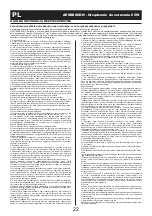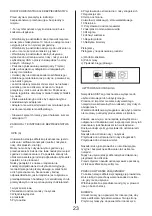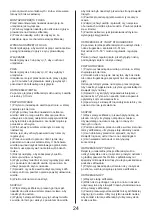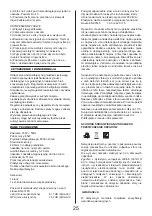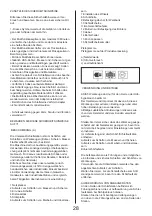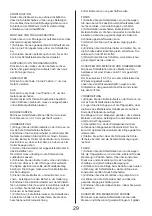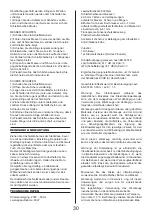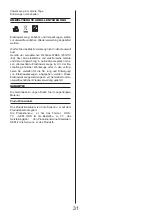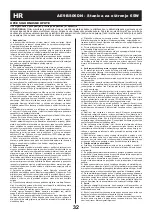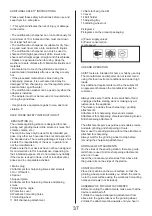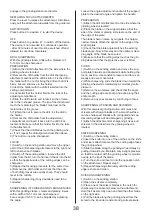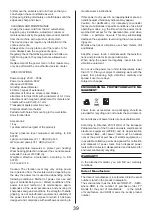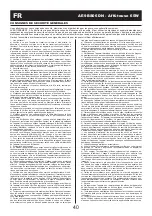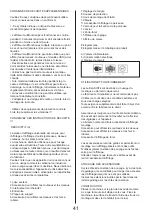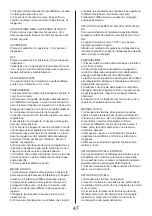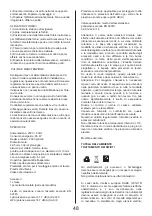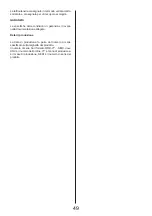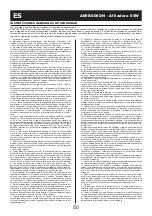
AE9BS06DN -
Multifunction sharepener 65W
EN
36
1. Working Environment
a) Keep the working area clean and well-illuminated. Mess and dark
spaces in the working area are the most common cause for injuries.
Please store the tools properly when not in use.
b) Do not use the power tool in the environment with the risk of fire
or explosion, i.e. in areas where flammable liquids, gases or dust are
present. Sparks are formed on the commutator of the power tool and
may cause ignition of dust or vapours.
c) When using power tools, prevent access of unauthorized persons,
in particular children, to the workspace! If distracted, you can lose
control of activities performed. Never leave power tools unattended.
Prevent access of pets/animals to the equipment.
2. Electrical Safety
a) The power cable plug of the power tool must match the wall sock
-
et. Never alter the plug in any way. Never use two-way adaptors or
any other adaptors with the tools having a protective pin in the power
cable plug. Undamaged plugs and matching sockets reduce the risk
of electric shock. Damaged and tangled power cables increase the
risk of electric shock. Should the power cable be damaged, it must be
replaced by a new power cable that may be acquired in our author
-
ized service centre or from the importer.
b) Avoid body contact with grounded objects, i.e. piping,
central heating radiators, cookers and refrigerators. Risk of electric
shock is increased when your body touches the ground.
c) Do not expose the power tool to rain, humidity or other wet condi
-
tions. Never touch the power tool with wet hands. Never wash the
power tool under running water. Never immerse it in water.
d) Do not use the power cable for any purpose other than for which it
is intended. Never carry or pull the power tool by its power cable. Do
not pull the plug from the socket by cable pulling. Prevent mechanical
damages to the electric cables by sharp or hot objects.
e) The power tool has been manufactured for powering by the alter
-
nating current. Always check the compliance of the voltage with the
rated voltage stated on the nameplate.
f) Never use the power tool with a damaged cable or plug, or which
fell to the ground and is damaged in any way.
g) Should you use an extension cable, always check the compliance
of its technical parameters with specifications stated on the name
-
plate. If the power tool is used outdoors, use an extension cable suit
-
able for outdoor use. When using extension drums, these must be
unwound to prevent cable overheating.
h) Should the power tool be used in damp areas or outdoors, it may
be used only if connected to an electric circuit with a circuit breaker
≤30 mA. Use of electric circuits with an RCD device reduces the risk
of electric shock.
i) Hold the hand power tool only by insulated surfaces intended for
gripping since the cutting or the welding equipment may touch a hid
-
den wire or the power cable of the tool during operation.
3. Personal Safety
a) When using the power tool, be attentive and vigilant, pay maxi
-
mum attention to the activity you are doing. Focus on work. Do not
use the power tool when tired or under the influence of drugs, alco
-
hol or medication. Even a moment of inattention when using a power
tool may result in a serious personal injury. When working with power
tools, do not drink, eat or smoke.
b) Use protective equipment. Always wear eye protection. Use pro
-
tective equipment corresponding with the type of work you are doing.
Protective equipment, e.g. a respirator, safety slip-resistant shoes,
headwear or hearing protection in accordance with conditions of work
reduce the risk of personal injury.
c) Avoid accidental power tool activation. Do not carry power tools
connected to the mains with your finger on the trigger or the switch
button. Before connecting to the mains, check that the switch or the
trigger is in the “off” position. Carrying of power tools with your finger
on the switch or inserting the power tool plug into a socket with a
switch being “on” may result in serious injuries.
d) Before switching the power tool, remove all adjustment wrenches
and other tools. The adjustment wrench or a tool that remains at
-
tached to the rotating part of the power tool may result in injuries of
bystanding people.
e) Always keep stable position and balance. Work only on areas that
you can safely reach. Never overestimate your own strength. Do not
use power tools when tired.
f) Dress appropriately. Wear working clothes. Do not wear loose-
fitting clothes or jewellery. Be careful not to allow your hair, clothes,
gloves or other parts of your body to get too close to the rotating or
hot parts of the power tool.
g) Connect an equipment for dust extraction. If the power tool may be
connected to an equipment for capturing or extraction of dust, make
sure
to connect the aforesaid equipment and use it properly. Use of such
equipment may reduce the dust-related risks.
h) Fasten the workpiece firmly. Use a carpentry clamp or a vice to
fasten a part intended for machining.
i) Dot not use the power tool, if you are under the influence of alco
-
hol, drugs, medication or other intoxicating or addictive substances.
j) This equipment is not designed for use by persons (including chil
-
dren) with reduced physical, sensory or mental capabilities or lack
of experience and knowledge, unless they are under supervision or
have been instructed with regard to use of the equipment by a person
responsible for their safety. Children must be supervised to be sure
that they do not play with the equipment.
4. Use and Maintenance of the Power Tool
a) Always disconnect the power tool from the mains in case of any
trouble during work, before each cleaning or maintenance, for each
relocation and after work. Never use the power tool if it is damaged.
b) Should the power tool start to emit an abnormal noise or odour,
stop the work immediately.
c) Do not overload the power tool. The power tool works better and
safer if operated in specified rpms. Use the right power tool designed
for your activity. The right power tool works better and safer if being
used for work for which it has been designed.
d) Do not use power tools that cannot be safely switched on and
switched off by the switch button. Use of such tools is dangerous.
Defect switches must be repaired in an authorized service centre.
e) Disconnect the power tool from the power source before your start
its adjustment, exchange of accessories or maintenance. This will
prevent the risk of accidental starting.
f) Power tools not being used must be kept stored away from chil
-
dren and unauthorized persons. Power tools in hands of inexperi
-
enced users may be dangerous. Store the power tools in a dry and
safe place.
g) Keep the power tool in good conditions. Check the adjustment of
moving parts and their looseness regularly. Check for possible dam
-
ages of protective covers or any other parts that may endanger the
safe operation of power tools. If the power tool is damaged, ensure
its proper repair before its further use. Many injuries are caused by
poorly maintained power tools.
h) Cutting tools must always be sharp and clean. Properly maintained
and sharpened tools facilitate work, reduce the risk of injury and work
with such equipment is controlled much easier. Use of other acces
-
sories than specified in the manual may result in damages to the tools
and personal injuries.
i) Use power tools, accessories, other tools, etc. in accordance with
these instructions and in a manner that is determined for a particular
power tool and with regard to the working conditions and the type of
work. Use of the tools for purposes other than specified may result in
dangerous situations.
5. Use of Battery-Driven Power Tools
a) Before inserting the battery, make sure the switch is in “0-OFF”
position. Battery insertion into a tool that is switched on may result in
dangerous situations.
b) To charge the batteries, always use chargers specified by the
manufacturer. Use of chargers determined for other battery types may
result in damaging and cause a fire.
c) Use batteries determined for the particular power tool only. Use of
other battery types may result in personal injuries or cause a fire.
d) If not being used, store the battery separately from metal objects,
e.g. clamps, wrenches, screws and other small metal objects that
could cause connection of one battery terminal with another. Battery
short-circuiting may cause injuries, burns or cause a fire.
e) Handle the batteries with care. Rough handling may result in leak
-
age of chemicals from the battery. Avoid contact with such substanc
-
es. If you still come into contact with them, wash the affected area
with running water. If the chemical substance gets into eyes, seek
medical advice immediately. Battery chemicals may cause serious
injuries.
6. Service
a) Do not exchange any parts of the power tool, do not repair it or do
not otherwise temper the power tool structure. Repairs of the power
tool must be carried out by qualified persons.
b) Any repair or modification of the product without authorization by
our company is forbidden (may result in injuries or damages).
c) Power tools must always be repaired in an authorized service cen
-
tre. Use only original or recommended spare parts. This will help you
to ensure your safety and safety of your power tool.
gENEraL SaFETY iNSTrUCTiONS
Please read, remember and keep these safety instructions for future reference
WARNING: When using electric machines and power tools, always comply with the following safety instructions to protect against an electric shock,
personal injury or the risk of fire. Within the meaning of these instructions, the expression “power tool” means both power tools powered from the
mains (power cable) and power tools powered from batteries (no power cable).
Keep all warnings and instructions for future use.
Summary of Contents for AE9BS06DN
Page 4: ...4 ...
Page 66: ...www rs we com ...

